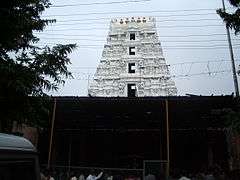Mallikarjuna Jyotirlinga
| Sri Mallikarjuna Jyotirlinga | |
|---|---|
|
Entrance to Srisailam Devasthanam | |
| Name | |
| Other names | శ్రీ మల్లికార్జున స్వామి జ్యోతిర్లింగము |
| Proper name | Sri Mallikarjuna Jyotirlinga Temple |
| Devanagari | श्री मल्लिकार्जुन ज्योतिर्लिंग देवस्थान |
| Geography | |
| Coordinates | 16°04′27″N 78°52′05″E / 16.07417°N 78.86806°ECoordinates: 16°04′27″N 78°52′05″E / 16.07417°N 78.86806°E |
| Country | India |
| State/province | Andhra Pradesh |
| Locale | Srisailam |
| Culture | |
| Primary deity | Mallikarjuna (Shiva) |
| Important festivals | Maha Shivaratri |
Sri Mallikarjuna Swamy is one of the twelve Jyotirlingas of Lord Shiva situated at Srisailam in South Indian state of Andhra Pradesh.[1] It is one of the 275 Paadal Petra Sthalams.
Jyotirlinga
As per Siva Mahapuranam, once Brahma (the Hindu God of creation) and Vishnu (the Hindu God of saving) had an argument in terms of supremacy of creation.[2] To test them, Shiva pierced the three worlds as a huge endless pillar of light, the jyotirlinga. Vishnu and Brahma split their ways to downwards and upwards respectively to find the end of the light in either directions. Brahma lied that he found out the end, while Vishnu conceded his defeat. Shiva appeared as a second pillar of light and cursed Brahma that he would have no place in ceremonies while Vishnu would be worshipped till the end of eternity. The jyotirlinga is the supreme partless reality, out of which Shiva partly appears. The jyotirlinga shrines, thus are places where Shiva appeared as a fiery column of light.[3][4] Originally there were believed to be 64 jyotirlingas while 12 of them are considered to be very auspicious and holy.[2] Each of the twelve jyotirlinga sites take the name of the presiding deity - each considered different manifestation of Shiva.[5] At all these sites, the primary image is lingam representing the beginningless and endless Stambha pillar, symbolizing the infinite nature of Shiva.[5][6][7] The twelve jyotirlinga are Somnath in Gujarat, Mallikarjuna at Srisailam in Andhra Pradesh, Mahakaleswar at Ujjain in Madhya Pradesh, Omkareshwar in Madhya Pradesh, Kedarnath in Himalayas, Bhimashankar in Maharashtra, Viswanath at Varanasi in Uttar Pradesh, Triambakeshwar in Maharashtra, Vaidyanath at Deoghar district in [Jharkhand ], Nageswar at Dwarka in Gujarat, Rameshwar at Rameswaram in Tamil Nadu and Grishneshwar at Aurangabad in Maharashtra.[2][8]
Story
When Shiva and Parvati decided to find suitable brides for their sons, Ganesha and Kartikeya argued as to who is to get wedded first. Lord Shiva bade that the one who goes round the world in Pradakshinam could get married first. By the time Lord Kartikeya could go round the world on his vahana, Lord Ganesha went round his parents 7 times (for according to Shastras, going in pradakshinam round one's parents is equivalent to going once round the world (Bhupradakshinam). Lord Siva got Buddhi(intellect), Siddhi (spiritual power), and Riddhi (prosperity) married to Lord Ganesha. kartikeya on his return was enraged and went away to stay alone on Mount Kravunja in the name of Kumarabrahmachari. On seeing his father coming over to pacify him, he tried to move to another place, but on the request of the Devas, stayed close by. The place where Lord Siva and Parvati stayed came to be known as Shrishailam. Lord Siva visits Lord Kartikeya on Amavasya day & Parvati Devi on Poornima. The temple is situated facing East. The center mandapam has several pillars, with a huge idol of Nadikeshwara.
Mahashivratri is the main festival celebrated at Srisailam Mallikarjuna Swamy temple.
The Holy Shrine of Srisailam Sri Mallikarjuna Swamy as a Shakti Peeth

Srisailam Sri Mallikarjuna Swamy Temple is one of the 18 Maha Shakti Peetha. The mythology of Daksha yaga and Sati's self immolation resulted in the emergence of Sri Parvati in the place of Sati Devi and making Shiva a house holder. This mythology is the story behind the origin of Shakti Peethas. They are holy abodes of Adiparashakti formed due the falling of Sati Devi's corpse when Shiva carried it and wandered. It is believed that Sati Devi's Upper lip has fallen here.[9][10][11]
References
- ↑
- 1 2 3 R. 2003, pp. 92-95
- ↑ Eck 1999, p. 107
- ↑ See: Gwynne 2008, Section on Char Dham
- 1 2 Lochtefeld 2002, pp. 324-325
- ↑ Harding 1998, pp. 158-158
- ↑ Vivekananda Vol. 4
- ↑ Chaturvedi 2006, pp. 58-72
- ↑ (Translator), F. Max Muller (June 1, 2004). The Upanishads, Vol I. Kessinger Publishing, LLC. ISBN 1419186418.
- ↑ (Translator), F. Max Muller (July 26, 2004). The Upanishads Part II: The Sacred Books of the East Part Fifteen. Kessinger Publishing, LLC. ISBN 1417930160.
- ↑ "Kottiyoor Devaswam Temple Administration Portal". http://kottiyoordevaswom.com/. Kottiyoor Devaswam. Retrieved 20 July 2013. External link in
|work=(help)
Notes
- Chaturvedi, B. K. (2006), Shiv Purana (First ed.), New Delhi: Diamond Pocket Books (P) Ltd, ISBN 81-7182-721-7
- Eck, Diana L. (1999), Banaras, city of light (First ed.), New York: Columbia University Press, ISBN 0-231-11447-8
- Gwynne, Paul (2009), World Religions in Practice: A Comparative Introduction, Oxford: Blackwell Publication, ISBN 978-1-4051-6702-4.
- Harding, Elizabeth U. (1998). "God, the Father". Kali: The Black Goddess of Dakshineswar. Motilal Banarsidass. pp. 156–157. ISBN 978-81-208-1450-9.
- Lochtefeld, James G. (2002), The Illustrated Encyclopedia of Hinduism: A-M, Rosen Publishing Group, p. 122, ISBN 0-8239-3179-X
- R., Venugopalam (2003), Meditation: Any Time Any Where (First ed.), Delhi: B. Jain Publishers (P) Ltd., ISBN 81-8056-373-1
- Vivekananda, Swami. "The Paris Congress of the History of Religions". The Complete Works of Swami Vivekananda. Vol.4.
External links
| Wikimedia Commons has media related to Hemareddy Mallamma Temple at Srisailam. |


